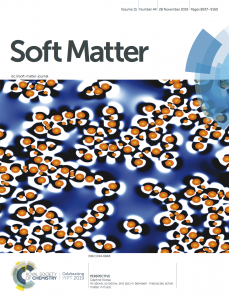Klotsa group’s latest article on the cover of Soft Matter
Assistant Professor Daphne Klotsa’s invited article makes it to the cover of Soft Matter. In this invited perspective Prof. Klotsa discusses the importance of studying mesoscale active matter in fluids. “Living matter, such as biological tissue, can be viewed as a nonequilibrium hierarchical assembly, where at each scale self-driven components come together by consuming energy in order to form increasingly complex structures. The remarkable properties of living or “active-matter” systems, as they are generally known, such as versatility, self-healing, and self-replicatin g, have prompted the following questions: 1) do we understand the biology and biophysics that give rise to these properties? 2) can we achieve similar functionality with synthetic active materials?” Klotsa says in her article. In this perspective Klotsa specifically focuses on why it is important to study active matter in fluids with finite inertia. Finite inertia is relevant for mesoscale organisms that swim or fly covering at least three orders of magnitude in size (≈0.5mm-50cm) and their collective behavior is generally unknown. “As a result, we are limited both in our understanding of the biology of mesoscale swarms and processes but also in our design of self-powered machines and robots at those scales. We expect interesting collective behavior to emerge because with finite inertia, come nonlinearities and the many-body hydrodynamic interactions between the organisms/particles can become quite complex, potentially leading to phenomena, such as novel flocking states and nonequilibrium phase transitions that have not been observed before and which could have great impact in materials applications.”
g, have prompted the following questions: 1) do we understand the biology and biophysics that give rise to these properties? 2) can we achieve similar functionality with synthetic active materials?” Klotsa says in her article. In this perspective Klotsa specifically focuses on why it is important to study active matter in fluids with finite inertia. Finite inertia is relevant for mesoscale organisms that swim or fly covering at least three orders of magnitude in size (≈0.5mm-50cm) and their collective behavior is generally unknown. “As a result, we are limited both in our understanding of the biology of mesoscale swarms and processes but also in our design of self-powered machines and robots at those scales. We expect interesting collective behavior to emerge because with finite inertia, come nonlinearities and the many-body hydrodynamic interactions between the organisms/particles can become quite complex, potentially leading to phenomena, such as novel flocking states and nonequilibrium phase transitions that have not been observed before and which could have great impact in materials applications.”
As Above, So Below, and also in Between: Mesoscale active matter in fluids
Soft Matter 15, 8946 (2019).
You can read the full article here.
You can read more about Klotsa’s research here.


